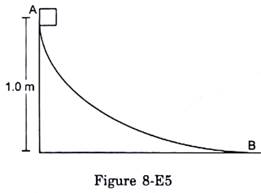A block weighing 10 N travels down a smooth curved track AB joined to a rough horizontal surface (figure 8-E5). The rough surface has a friction coefficient of 0.20 with the block. If the block starts slipping on the track from a point 1.0 m above the horizontal surface, how far will it move on the rough surface?

Coefficient of friction, μ = 0.20
Weight of the block = 10 N
Height of the point A, h = 1.0 m
Frictional force exerted on the block by the rough surface, F = μ × weight of the block
= 0.20 × 10
= 2 N
Let the displacement of the box from point A be s
Loss in potential energy = Work done by the frictional force = Fs
Weight of the block × h = 2 × s
10 × 1 = 2 × s
s = 5 m
∴ The block will move 5 m before stopping on the rough surface.
1